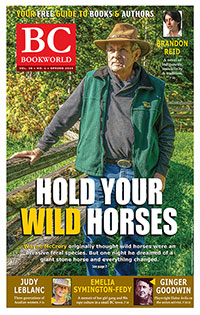LITERARY LOCATION: Spatsizi Plateau Wilderness Provincial Park
Ian and Sally Wilson twice dropped themselves by plane into remote areas of Spatzizi Park, once during a snowstorm, staying four months each time, enjoying no communication with the 'outside' world, in order to write their second book, Wild and Free: Living with Wildlife in Canada's North (Gordon Soules, 1989). They also conducted their field work during visits to Jasper, Wells Gray and Kluane national parks.
"We've found you have to first spend about a month living in one place, letting the animals get to know you," said Ian Wilson, "That's the only way you can end up petting a porcupine. We were even able to paddle eight feet in front of a moose."
Their goal for Wild and Free was to photograph and draw animals, closely observing the animals' behaviour. Then the husband n' wife team sat around their campfire with a laptop in the evenings, making a book.
"We've gone to areas where hunters say there's no game," said Ian Wilson, "but we can usually find lots of animals. Animals seem to have a sixth sense to tell them whether or not you mean them harm." Except for one bull elk in the Rockies.
Once, while photographing during rutting season, Ian Wilson was apparently mistaken for a rival. "I never knew how fast I could sprint with 30 pounds of equipment on my back. I ended up on one side of a sapling with the elk on the other, his antlers on either side of the sapling, battering away.
"Sally bugled and that made the elk turn around. Except for that one incident we've never felt any danger in the bush. Usually animals will give you a sign if you're getting too close."
Ian and Sally Wilson and Sally Tatlow Wilson were citydwellers when they went north to chronicle a year in a self-built cabin, 85 miles west of Iskut, for their first book, Wilderness Seasons (Gordon Soules 1987), illustrated by Sally Wilson.
Later, their Gold Rush, Reliving the Klondike Adventure (Gordon Soules $16.95) recorded the couple's year-long adventure travelling by horseback and hand-built scow, hiking old trails on foot and snowshoe, and panning for gold in the Yukon.
Among their many preparatory tasks was learning to tie a double diamond hitch. To do so, they attended a horse packing clinic in Aldergrove. Their first attempt took twenty minutes. After several hours of practice, they managed to cut their time down to a respectable ten minutes.
"Repeating the process on a real horse was much more challenging,"; says Ian Wilson. "This horse moved! It stepped nimbly aside when we attempted to load the boxes. It tried to nip me as I looped the rope over its withers. It stomped on my boot as I leaned close to tie a knot.";
They survived to tell their fourth wilderness tale and set off on a fourth, extensive, cross country, promotional tour, minus pack horses. Gregarious self-promoters, they once made 400 appearances during an 11-week cross-Canada publicity tour, usually presenting slide shows.
The Wilsons' success as self-marketers marked the advent of the commercial viability for self-publishers in B.C. during the onset of the new computerized era.
[BCBW 2016] "Outdoors"
Review of the author's work by BC Studies:
Gold Rush: Reliving the Klondike Adventure in Canada's North
Ian and Sally Wilson twice dropped themselves by plane into remote areas of Spatzizi Park, once during a snowstorm, staying four months each time, enjoying no communication with the 'outside' world, in order to write their second book, Wild and Free: Living with Wildlife in Canada's North (Gordon Soules, 1989). They also conducted their field work during visits to Jasper, Wells Gray and Kluane national parks.
"We've found you have to first spend about a month living in one place, letting the animals get to know you," said Ian Wilson, "That's the only way you can end up petting a porcupine. We were even able to paddle eight feet in front of a moose."
Their goal for Wild and Free was to photograph and draw animals, closely observing the animals' behaviour. Then the husband n' wife team sat around their campfire with a laptop in the evenings, making a book.
"We've gone to areas where hunters say there's no game," said Ian Wilson, "but we can usually find lots of animals. Animals seem to have a sixth sense to tell them whether or not you mean them harm." Except for one bull elk in the Rockies.
Once, while photographing during rutting season, Ian Wilson was apparently mistaken for a rival. "I never knew how fast I could sprint with 30 pounds of equipment on my back. I ended up on one side of a sapling with the elk on the other, his antlers on either side of the sapling, battering away.
"Sally bugled and that made the elk turn around. Except for that one incident we've never felt any danger in the bush. Usually animals will give you a sign if you're getting too close."
Ian and Sally Wilson and Sally Tatlow Wilson were citydwellers when they went north to chronicle a year in a self-built cabin, 85 miles west of Iskut, for their first book, Wilderness Seasons (Gordon Soules 1987), illustrated by Sally Wilson.
Later, their Gold Rush, Reliving the Klondike Adventure (Gordon Soules $16.95) recorded the couple's year-long adventure travelling by horseback and hand-built scow, hiking old trails on foot and snowshoe, and panning for gold in the Yukon.
Among their many preparatory tasks was learning to tie a double diamond hitch. To do so, they attended a horse packing clinic in Aldergrove. Their first attempt took twenty minutes. After several hours of practice, they managed to cut their time down to a respectable ten minutes.
"Repeating the process on a real horse was much more challenging,"; says Ian Wilson. "This horse moved! It stepped nimbly aside when we attempted to load the boxes. It tried to nip me as I looped the rope over its withers. It stomped on my boot as I leaned close to tie a knot.";
They survived to tell their fourth wilderness tale and set off on a fourth, extensive, cross country, promotional tour, minus pack horses. Gregarious self-promoters, they once made 400 appearances during an 11-week cross-Canada publicity tour, usually presenting slide shows.
The Wilsons' success as self-marketers marked the advent of the commercial viability for self-publishers in B.C. during the onset of the new computerized era.
[BCBW 2016] "Outdoors"
Review of the author's work by BC Studies:
Gold Rush: Reliving the Klondike Adventure in Canada's North
 Home
Home




